
When you read trip reports of birders going to remote and interesting locations to see interesting (and not so interesting birds, I’m looking at you LBJs), these accounts are typically written by people who have either gone with groups of like-minded people or those that have gone it alone. This is just as well, because there is nothing more prone to ruining a holiday (other than the outbreak of war or an unpleasant tropical malady) than subjecting people uninterested in birds to the lengths that birders go to seeing birds. Most normal people, having flown around the world to a tropical location, would understandably choose to head straight for the beach where outlandish alcoholic drinks are brought to your chair. There is some variation in this, of course, with some preferring a seat by the pool. What they don’t fancy is standing in a stinking sewer ditch flowing into a nasty swamp being bitten by hordes of disease carrying mosquitos at five in the morning because this is the place to see a small migratory reed warbler that only turns up here.
This is not to say, however, that birders on holiday are, should they choose to travel with family, friends or other assorted loved ones, resigned to seeing nothing, or even nothing except the common stuff. I’ve done a lot of birding with non birders, and while you may not see as much as you would on a dedicated trip, you can still see a lot. Often with a great deal more comfort than hard-core birding. And Borneo, I can report, is a particularly good place to travel with non birders and still see an awful lot (in comfort!).
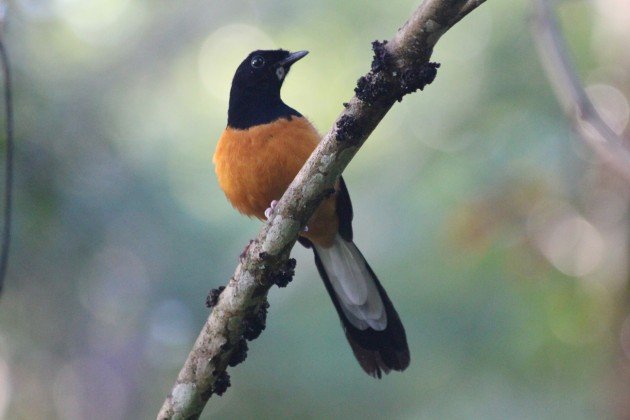 The White-crowned Shama is a stunning endemic.
The White-crowned Shama is a stunning endemic.
The reason Borneo lends itself to this type of birding holiday is that tourism in Borneo leans towards outdoorsy, wildlife based tourism anyway. People go to Borneo to hike the spectacular mountains, cruise down wild rivers, seek out exciting creatures and dive spectacular reefs. Contrast this in Asia to, say, Singapore, Hong Kong or Bangkok, all of which have great birding nearby but are destinations people go to for reasons other than wildlife. While Borneo is certainly sought out by birders, its tourism sector is broader than just that and thus can cater to and entertain people who may enjoy David Attenborough but don’t care about the difference between a White-rumped and White-crowned Shama, or to put it another way, keep my family happy.
I was thus able to pick an off-the-shelf ecotourism route and, having selected a company, customise it to my family’s needs. My mother is a keen horticulturist and gardener, so locations with interesting plants were a must, happily these happen to coincide with some of Borneo’s best birding. My brother, who works in outdoor environmental education and is happiest kicking over rotting logs to inspect insects was also easy enough to keep happy. My Dad is less of a biologist and more interested in history, but is also laid back and happy enough watching us have fun, but we even managed to find some historical sites to investigate.
We went with a local company, Borneo Eco Tours. To my mind it is always better to go local if you can, and it has never been easier now that you can make sure that the company whose tour you like the look of are not complete muppets by using reputation sites like Trip Advisor. One of the good things about Borneo Eco Tours, other than the ability to tinker with the tour endlessly before purchasing, was that for an extra fee we were able to secure a guide who was able to competently identify birds for us. In fact they were almost too good, as they are used by visiting birding trips and I had to gently explain at the start that while we wanted birds identified we were not a birding party and that there would be a mutiny if we tried to act as one. Having established this we benefited from excellent guides who were able to point out plenty of birds to me without boring everyone else. One of the guides we had was even as knowledgable about orchids and other flowering plants, to my mother’s delight. And besides, I was always able to sneak off early when everyone else was still in bed to get some extra birds in.
Mainland Borneo in the distance, dominated by Mt Kinabalu
And the birds? I saw plenty. Between the 22 of December and the 31st I managed to see 171 species of bird, this had climbed to 219 by the time I had left of the 11th of January. This included 5 days without family, but I didn’t get more than 35 extra species without them. I could have gotten a lot more if post new year I had spent more time in lowland forests rather than montane forests or offshore islands. I missed quite a few of the biggies that people really covet in Borneo, most painfully the Whitehead’s Trogon and Bornean Bristlehead, but also the Whitehead’s Broadbill, Bornean Banded Pitta, Rail Babbler and Friendly Bush-warbler (which honestly I really didn’t try for). But I did pick up some astonishing species, including five broadbills, three pittas, six hornbills, the Storm’s Stork, White-fronted Falconet, Pygmy Ibon, Mountain Black-eye, Mountain Serpent Eagle and Bat Hawk.
I’ll be doing pieces in these locations over the coming weeks, but for now here is a quick overview of the sites and in particular how they may fare with non birders.
Mount Kinabalu
The mountains of the Crocker Ranges are a must for visiting birders and happily also on the main tourism route. Mount Kinabalu is an astonishing hot spot of biodiversity and held huge amounts of interest for people interested in plants and insects – it’s also really good for squirrels. It is very popular with mountain climbers and hikers, with plenty of trails and great views when the mountain isn’t covered in cloud. Birding can be very slow, be sure to come at dawn to get the first two hours, then make it back in time for breakfast as everyone gets up! This site can be done as a day trip from the coastal resorts at a pinch, but can be combined with some of the other local attractions. The birds here may be hard but are worthwhile, highlights for me were Orange-backed Woodpeckers, a Bornean Green Magpie, Crimson-headed Partridges and a tiny Bornean Stubtail.
Another endemic, the Chestnut-hooded Laughingthrush
Tabunan Rafflesia Centre
Also in the Crocker Ranges, this site is probably a miss for non-birders if the massive Rafflesia flowers are not, well, flowering. For good reasons the paths are not open if there are no flowers, and this limits visitors to a busy mountain road, although there is a small orchid and butterfly farm on the road up. The birds here are really good, but it is perhaps best done as a day trip leaving the family on the beach near the coast. Highlights for me were the endemic Mountain Serpent Eagle, Bornean Leafbird, Mountain Barbet and Long-tailed Broadbill.
Poring Hot Springs
You’re pretty much guaranteed a visit here on any tour that includes Mount Kinabalu, and despite being uncharitably dubbed Boring Hot Springs, this location is worth visiting. It’s good for mid-mountain birding and a elevated canopy walkway which can yield birds even when crowded with visitors. The hot springs will attract hundreds of people and be very crowded, which may make the place less enticing. Another good thing about the area is that it represents a better place to find a Rafflesia flower, and learn about the local conservation project for the floral highlight. Highlights for me were the Rafflesia flowers, a very close Black-and-yellow Broadbill, Scaly-breasted Bulbuls, a Malaysian Hawk-cuckoo, and a flying lizard.
Mantanani Island
Go to Sipadan instead.
Sepilok
One of the most popular tourism locations in Borneo, this is where people go to see Bornean Orangutans at the world-famous rehabilitation centre. The area also boasts a Rainforest Discovery Centre with several canopy walkways and towers, and a newer rehabilitation centre for bears. Combine this with one of the best places to watch lowland species and you’ve got a winning combination of entertainment for birders and non-birders alike. One recommendation I can make is the night walks in the Orangutan Centre, which got us snakes, a Sunda Stink-badger and a sleeping Hooded Pitta.
Kinabatangan River
Another must do for birders and non-birders. The Kinabatangan River is a long snake of water winding through a patchwork of remnant forest and palm oil plantations, dotted with villages and jungle resorts catering to all budgets. The highlight is the river, and each morning and evening boats work their way up and down the rivers with tourists looking for Asian Elephants, Bornean Orangutans, Proboscis Monkeys, Saltwater Crocodiles and other exciting animals. The truly lucky might see Bornean Clouded Leopards or the endemic Flat-faced Cat at night. Think of the Jungle Ride at Disney. The birding is as good as the other wildlife, this being the best place in the world to see the endangered Storm’s Stork, as well as the best place to see all eight of Borneo’s Hornbills, but birds of prey, herons, kingfishers, Oriental Darters and many other birds can be seen. If you’re not with birders you’ll have less luck with the smaller species (tourists looking for elephants are unlikely to wait to see a small White-chested Babbler that your guide heard), but you’ll still leave with lots of great memories. Too many highlights, but I have to shout out the Rhinoceros Hornbill as a runner up for my bird of the year last year. (Never did see an elephant though).
The River in the afternoon
Even non-birders appreciate Wrinkled Hornbills
Gottamong Caves
Think of a horrifying Dantesque portal to hell in the middle of a pleasant patch of primary rainforest and that’s Gottamong Cave, at least if you’re someone crippled by a specific type of claustrophobia that I have (caves plus bat guano is pretty much the worst fear I have). A popular location for BBC film crews, this is the place to come and tick the swift species that can only be separated by the type of nest they make. Redeemed in the eyes of this cave unenthusiast by the forest with Crested Serpent-eagles, Black-and-Crimson Pittas, and Bushy-crowned Hornbills. Make sure your itinerary drops you here in the afternoon and evening, because the sight of a million Wrinkle-lipped Bats leaving for the night and being hunted by Bat Hawks is a damn impressive sight, for birder and non-birder alike.
The entrance to hell has a walkway
Danum Valley
You need to go to the Borneo Rainforest Lodge. If you can’t afford to go to the lodge on a trip to Borneo, and it is crazy expensive, don’t go. Go somewhere else, and go to Borneo when you can afford to go here. Everything here is as crazy good as it is crazy expensive. The food, the service, the standard of the guides, the birds. My God the birds. Sure, there are small niggles, but at the end of the trip it was the place that my parents said that, after two nights, they wanted to come back to and spend longer at (along with Sipadan, the one highlight we didn’t visit). Non birders will enjoy the luxury of a five star resort in an exciting primary rainforest location. Birders will drool themselves dry at the sight of species like Blue-headed Pittas, Pygmy Ibons, Banded Kingfishers, Dusky Broadbills, and the astonishing Great Argus. Oh, and mammals like Bornean Orangutans, Bornean Gibbons, Banded Civets, Bearded Pigs and Maroon Langurs. And, to be honest, the cocktails after you’ve been out for a day of lowland birding.
The Moustached Babbler is one of many lowland babblers you can find in Danum!
So be sure to go to Borneo, and take your family!

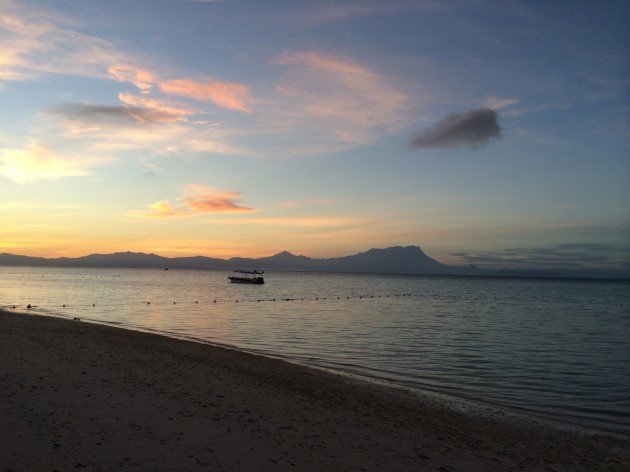
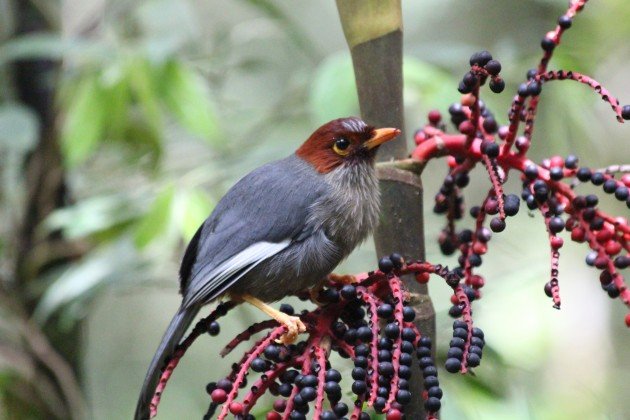
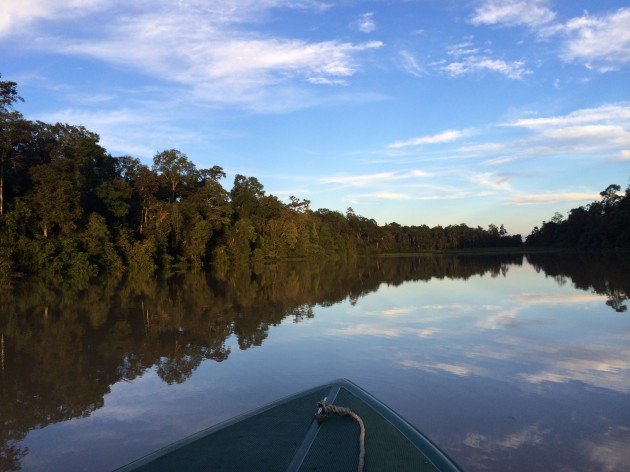
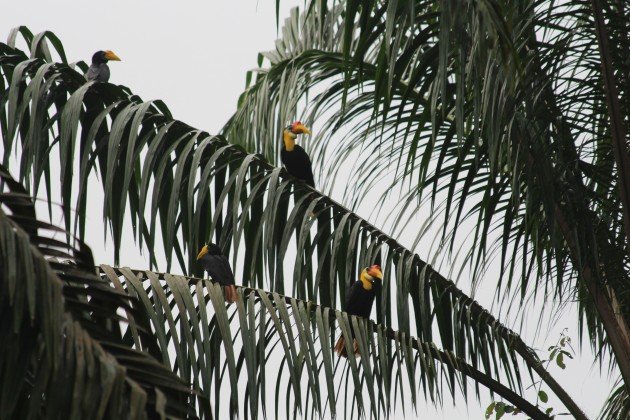
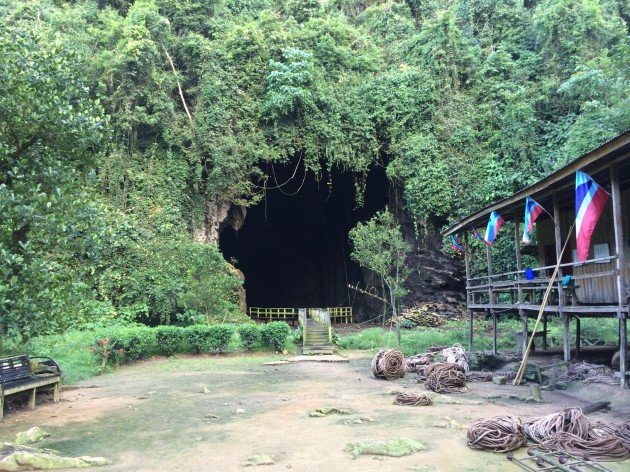
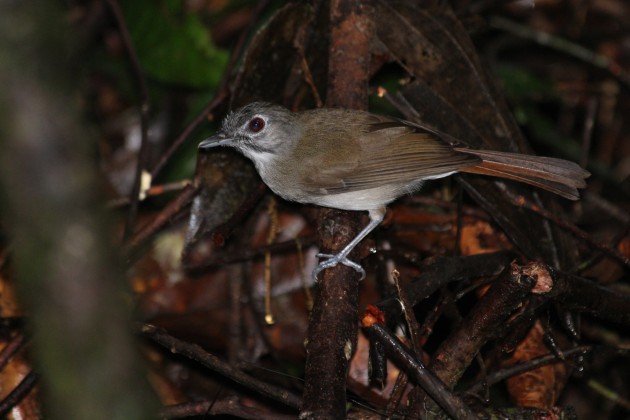










I love birding treks like these….especially when the tourism of that country is geared towards the outdoors. Great birds!
Unbelievable, Duncan. You’ve just nailed Borneo to my bucket list!
That’s quite a good bunch of birds for a family trip! Dang do I want to go there!
Borneo is brilliant ! Plenty of primates at the Kinabatangan River. Don’t forget that Danum Valley Field Centre is a decent alternative to Borneo Rainforest lodge… but generally, you can’t go wrong.
John, the Danum Valley Field Centre is perhaps fine for students and very hardcore birders, but I stand by my advice that you should go to the Jungle Lodge or not at all. This is doubly and absolutely true if you have non birders in tow. There is no correct way to bird and travel, but the Jungle Lodge is such a birder treat, and thee is sooooo much to do in the world that most people will only get one shot at Borneo, so if you do then do it right.